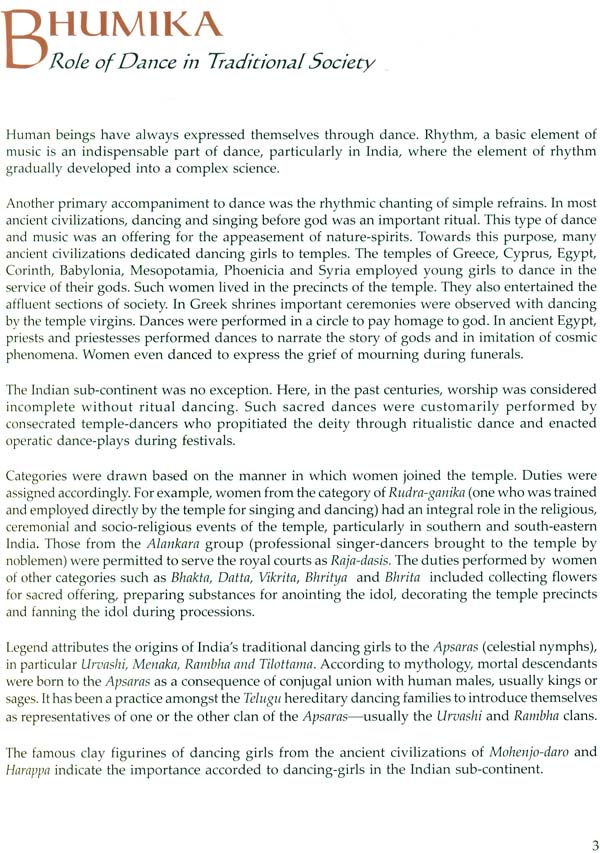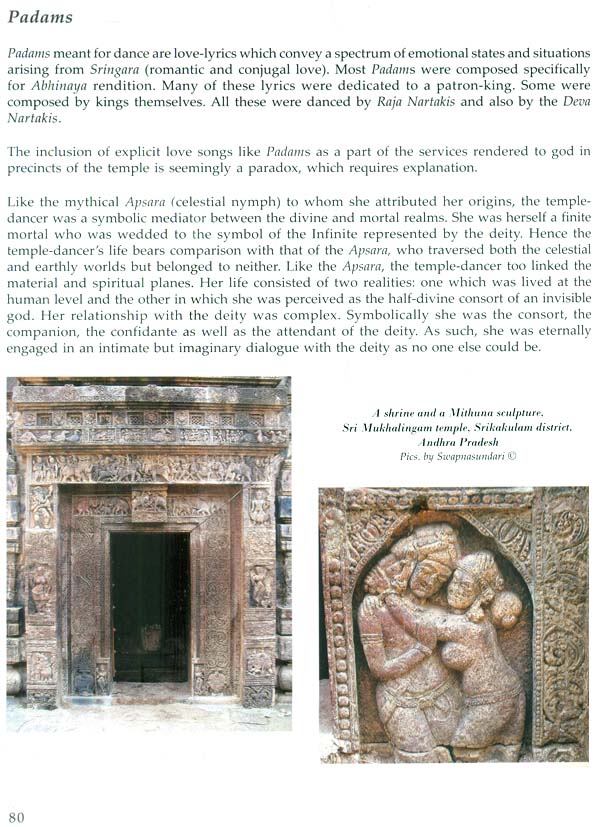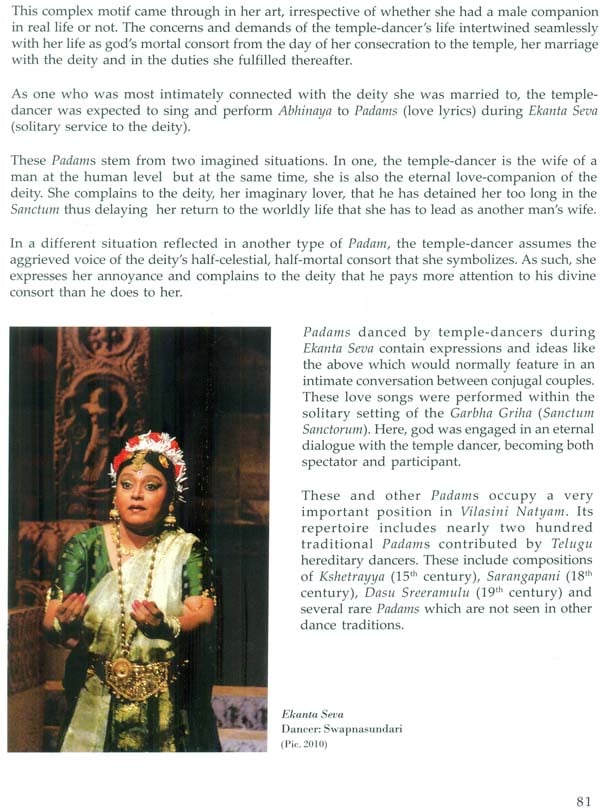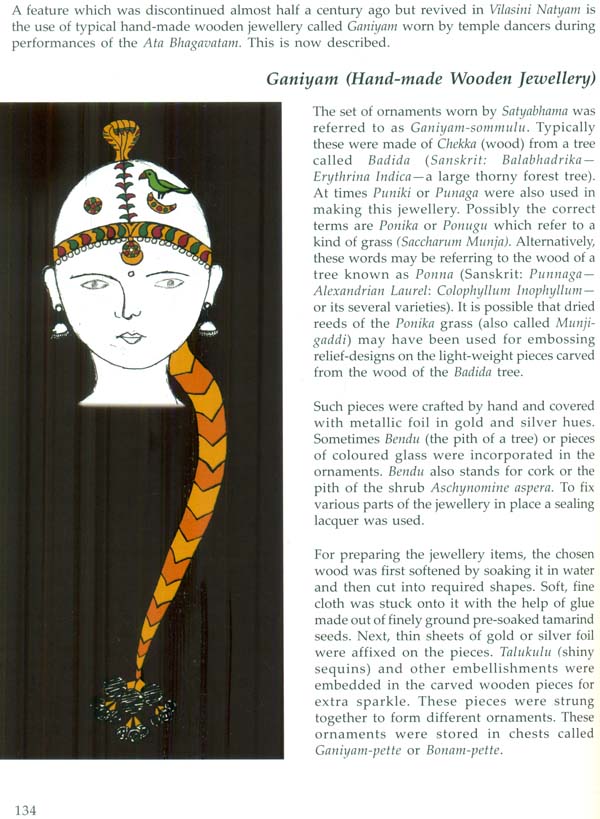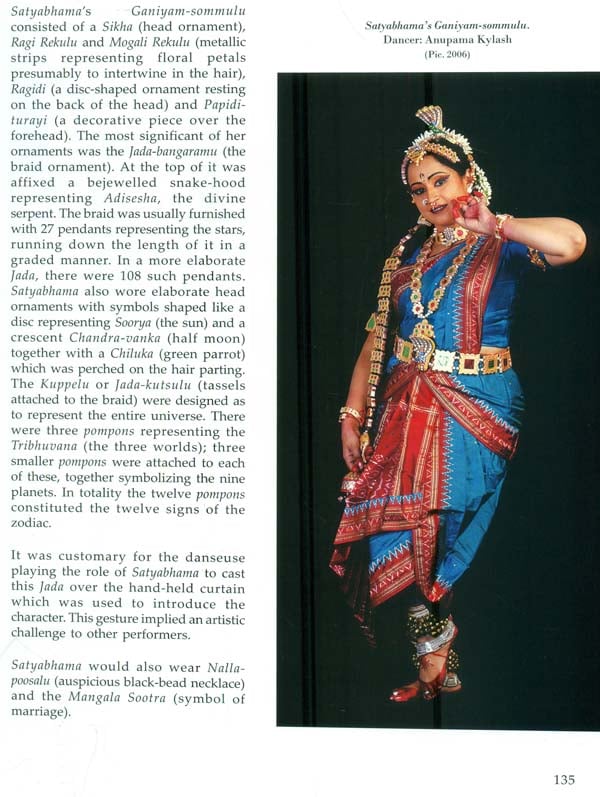
Vilasini Natyam - Bharatam of Telugu Temple and Court Dancers
Book Specification
| Item Code: | NAP424 |
| Author: | Swapnasundari |
| Publisher: | Swapnasundari |
| Language: | English |
| Edition: | 2010 |
| ISBN: | 9788184651478 |
| Pages: | 163 (Throughout Color and B/W Illustrations) |
| Cover: | Hardcover |
| Other Details | 11.0 inch X 9.0 inch |
| Weight | 1.20 kg |
Book Description
All cultural forms have a complex relationship with the history of the region of their genesis and development the fine arts and literary traditions of the Telugu-speaking people extended to large parts of southern and south-eastern India, well beyond the confines of the modern state of Andhra Pradesh.
One such performing tradition was practiced by Telugu temple and court dancers. Now re¬incarnated as VilaSini Natyam, it is recognized as one of India's major dance-traditions.
Vilasini Natyam has drawn the attention of the connoisseur as well as the general viewer and evoked appreciation from both.
This book Presents a comprehensive and cohesive account of the origin, rise, decline and re-emergence of the Telugu temple-court performing tradition. It explains and situates the art-form within its historical and ethnographic contexts.
The book has ten chapters. It contains over 200 photographs, many of which appear in print for the first time
About the Author
Swapnasundari is a distinguished professional Indian classical dancer-singer and scholar, proficient in Bharata Natyam, Koochipoodi, Vilasini Natyam and vocal music. She has travelled all over the world for her performances.
She received the Padma Bhushan in 2003, becoming its youngest recipient in her genre of art. She is decorated with several other honours including the Central Sangeet Natak Akademi award.
Swapnasundari's most notable contribution to Indian classical dance is considered to be the comprehensive reclamation of the art-form previously practiced by Telugu temple-court dancers and its successful recasting as Vilasini Natyam.
She is the first and only dancer in post-Independence India to restore Agamic dances to a temple as a part of worship. Since 1996, Swapnasundari has been dancing these annually at the Brahmotsavam of Sri Ranganatha Swamy temple, Hyderabad.
Author of another book called The World of Koochipoodi Dance, Swapnasundari also contributes articles on aspects of culture for various publications. She lives in Delhi and teaches dance in Delhi and Hyderabad.
There has been a strong need to view the performing traditions of the Telugu people against the larger backdrop of historical events. The origin, development, decline and regeneration of these traditions can be better understood when seen from such a perspective.
As a Telugu myself, I have been long fascinated by the rich cultural heritage of my people. Even during the initial stage of my professional career as a Bharata Natyam and Koochipoodi dancer I used to take every opportunity to explore temples and historical sites and visit museums. In subsequent years I spent considerable time studying rare books and manuscripts related to my interests, sourcing these from public libraries, private collections and well-known manuscript repositories. The study yielded interesting information which reaffirmed the following that, Indian dance-traditions including those 'officially' classified as 'classical' dance-styles are varying adaptations of the basic principles of Bharatam.
That, during the rule of the Kakatiyas and even earlier, such a 'classical' solo dance-songtradition had prevailed in the temples and courts in the Telugu land which was performed exclusively by hereditary female dancers.
That, for several centuries these Telugu dancers practiced a distinctive form of Bharatam throughout the Telugu-speaking regions of peninsular India including the Tanjavur and Madura regions in present-day Tamil Nadu.
That, from the time of the rule of Surya-Vamsa Gajapatis and perhaps even earlier until the last century, a section of this community of Telugu temple-dancers (locally known as the Telanga Sampradaya of Maharis) have also rendered dance and song service at the Puri Jagannatha temple in present day Orissa.
That, according to the Madras census report of 1881, there were 11,573 women dancers in the (Madras) Presidency. Evidently this included Telugu temple-court dancers since southern India was separated into Andhra Pradesh, Tamil Nadu and Karnataka only much later.
That, Telugu hereditary dancers who served many temples and royal courts in the erstwhile Madras Presidency were clubbed together with their Tamil counter-parts by writers in colonial and post-colonial India who referred to them by the collective term Tanjore dancers. This added to the prevailing state of confusion in so far as the identity of the Telugu people's Bharatam was concerned.
That, Telugu hereditary dancers who served many temples and royal courts in the erstwhile Madras Presidency were clubbed together with their Tamil counter-parts by writers in colonial and post-colonial India who referred to them by the collective term Tanjore dancers. This added to the prevailing state of confusion in so far as the identity of the Telugu people's Bharatam was concerned.
The historicity of the Bharatam of Telugu temple-court dancers and the denial of a distinct position for their art motivated me to take effective and timely steps to reclaim and restore this valuable performing tradition to its full glory.
The historicity of the Bharatam of Telugu temple-court dancers and the denial of a distinct position for their art motivated me to take effective and timely steps to reclaim and restore this valuable performing tradition to its full glory.
I made several trips to different parts of present day Andhra Pradesh as well as its neighbouring regions to meet, interview and document the dance-demonstrations and talks by a number of aged Telugu hereditary artists from the erstwhile temple-court dance tradition. Their impromptu dance-demonstrations were so effective that my intent to learn and master their system of dance was further strengthened. After a great deal of persuasion, some of them agreed to teach me.
While learning the Telugu temple-court Bharatam I was impressed by the characteristic feminine beauty of its dance movements and the sheer enormity of the dance repertoire. I suspended my stage concerts and other professional activities for some time in order to fully grasp the nuances of the form of Bharatam being taught to me by my new Gurus. In the decade that followed, this tradition, reincarnated as Vilasini Natyam, was widely performed by me all over the country.
Many of my objectives related to the furtherance of this performing tradition have been achieved during the last decade and half. Presently, while my own performances continue, the reach of Vilasini Natyam is being extended by my disciples as well.
In the present book I have addressed some other concerns regarding the performing arts of the Telugu people. Most books written in the English language on Indian performing traditions have discussed only those dance-forms of the Telugu people which are presently fostered in the modern state of Andhra Pradesh. A reappraisal of the dance-forms of the Telugu people from a much broader perspective is now required.
Telugu language has a rich and extensive literature dating over 2000 years, a substantial portion of which was developed by Telugu settlers in regions outside the state of Andhra Pradesh as it stands today. This is equally true of the Telugu people's fine arts.
Manuscript repositories in present-day Andhra and outside abound with musical texts and Treatises composed by Telgue Vaggeyakaras (lyrics –cum-music-composers). There are innumerable works composed in Sanskrit and in the vernacular by Telugu writers, dealing with Tara (rhythmic System), Swara (melodic System) and music applied to dance.
Given the eventful political and cultural history of the Telugu people this is hardly surprising from ancient times andharas led successful marine expeditions from the sea-ports they controlled. They excellent in maritime trade and industry. Their various dynasties waged wars and founded impires which ruled over large regions of southern and south-eastern India. They built monuments of great architectural beauty and supported the arts.
Political developments, Socio-economic Changes , the rise and decline of Saivism Vaishnavism, Jainism and Buddhism, the Revival of Vedism and other Factors influenced the pattern and degree of patronage that was extended to the fine arts of the Telugu people.
To a great or small extent, all such changes shaped the destiny of the fine arts, including Vilasini Natya. Hence this book discusses this performing tradition against the larger perspective of telugu cultural history ,in particular from the time of the kakatiya rules.
